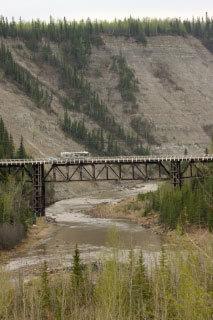 Day 2 - May 17 - Fort Nelson, BC
Day 2 - May 17 - Fort Nelson, BC Chapter 2. The Alaska Highway
 Day 2 - May 17 - Fort Nelson, BC
Day 2 - May 17 - Fort Nelson, BC (Shari) Seven-thirty comes too early to me, but it seems everyone else is ready to go. We say goodbye to Dawson Creek as we head west and north. A small detour takes us over an original stretch of the Alaska Highway and the historic wooden 531-ft. Kiskatinaw River Bridge. A sign before the bridge warns drivers to travel one at a time and slowly. I alternate between closing my eyes and telling Bert to hurry across before the bridge cracks with our weight. We all make it and certainly have pictures to prove it. I see a Black Bear a little while later and then two Moose crossing the highway in front of us. This is our fifth time traversing this route and every year the scenery is a little different. The people tell me spring is about two weeks late this year but I think today the trees made up for lost time. The forest has a fuzzy lime green hue reminding me of a Monet painting. Bert told me a few years back that he did not think he had enough spring times left in his life. This year our spring has lasted since we left Texas over six weeks ago. There leaves were totally mature, if young. Then we hit Wisconsin with its bare limbs and now we see green fuzz. Today’s warm sunny weather will speed spring along I am sure. Our first stop is for the promised cinnamon rolls that are delicious and huge as usual. Next is a bird/lunch stop before we finally reach our destination at Fort Nelson. We barely have time to refuel and get settled before Bert talks about the periglacial activity. We snack on nachos, chips and trail mix. We have helpers to do set up and clean up and I personally thank Ann, Chris, Joann, Bill A, Curtis and Marie for their contributions.
(Bert) In 2002, my journal for this exact date and travel distance states, “Spring is barely in evidence along the start of the Alaskan Highway.” In 2006 I wrote, “Although we pass some aspen groves still absent of leaves, most are a third to a half leaved. Clumps of green grass poke through last fall’s dusky brown remnants.” This year I’d say we have a bit of both. Aspen leaves are beginning to appear, but miles of unadorned trees are also in evidence and brown grass far surpasses green. As in other years, the tops of distant mountains are dusted in white snow. Bird and mammal highlights include a far western location for Blue Jay which I see just after we leave the Kiskatinaw River Bridge at mile 19, a Pileated Woodpecker at Shepherd’s Inn and another at the Mile 260 rest stop, the single Common Nighthawk we watch fly over the marsh behind Mae’s Kitchen, the Warbling Vireo John finds at Shepherd’s Inn and a Horned Lark I saw flying at mile 248. I’d say the best bird along the route is the Northern Shrike that only Marie saw, at mile 94. Mammal sightings were multiple and Shari takes the prize for spotting the most, including a Black Bear at 77, two Moose at 145 and another at 174. Marie saw a Red Fox at Charlie Lake and others reported Snowshoe Hare, Red Squirrel and Mule Deer. In camp at Fort Nelson, I give a short talk on periglacial effects since we will be seeing many of them in the next thousand miles, Shari follows with a travel meeting and we then enjoy the snacks that she and Donna prepared. At 7:35 PM as I’m taking out the garbage I see a flock of white birds calling as they fly just beyond the campsite and I quickly run back to R-Tent-III and shout to Shari to hand me my binoculars. Jim and Donna see my excitement and rush out of their rig as well. We watch a flock of over 70 Tundra Swans wing across the Alaska Highway. That tops off a beautiful warm evening, still generously bright at 9 PM when the outside thermometer reads an unusual warm 70º.
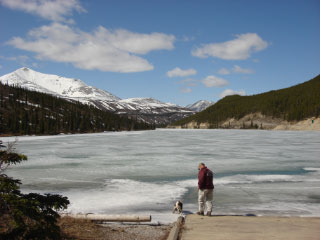 Day 3 - May 18 – Toad River and Muncho Lake, BC
Day 3 - May 18 – Toad River and Muncho Lake, BC (Bert) Today’s stretch of the Alaska Highway includes incredible scenery, doubly enhanced by good weather and clear skies. At Steamboat Mountain the distant horizon is snow-covered mountains, the northern edge of the Canadian Rockies. Marie tells a story of when she crossed Steamboat Mountain with her parents in March 1953. Of course then the trees came to the edge of the narrow road and conditions were not the smooth well-paved roads we see today. Another vehicle started to slide off the road and passengers jumped out, but the driver rode the vehicle downhill in a slide. Marie’s father drove the family to the nearest town where the Canadian Mounties returned with a crane to pull out the vehicle. Today the highway does not look intimidating and we cross the peak with ease, enjoying the grand view from the top. The next area we come to is even higher. At 4248 ft., Summit Pass is the highest point in the Alaska Highway and the crews in 1942 had a difficult time with its construction. With steep snow-covered mountains at sides, Summit Lake is still iced over and supports the weight of Bill and Ginny’s dog Meg, but I wouldn’t trust it with my weight. An icy wind blows off the lake and I’m glad I put on an extra coat before coming outside.
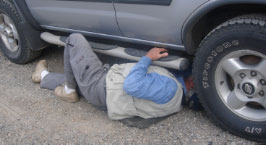 We reach Toad River by 11:30 and park our RV’s in campsites. The pull-throughs
are all taken by the time I park, so I begin unhitching our SUV from R-Tent-III.
As I engage the drive-shaft disconnect I am surprised at how easy the lever
moves and the absence of the usual clattering noise when the gear connects. I
get out of the car and look under the vehicle to check the connection. To my
utter amazement I discover that the drive shaft is missing. I can’t believe my
eyes! This 5-ft. heavy metal shaft joined on each end by U-joints is completely
absent. How could it have loosened and fallen from the vehicle without us
knowing it or the RV’s behind us seeing a big junk of metal bouncing out from
underneath the car? I ask Chris and Curt to move their Class A motorhome to a
back-in site and I pull into theirs. Looks like we will need to tow the car all
the way to Anchorage, without unhooking, before we can buy a new driveshaft and
have it mounted.
We reach Toad River by 11:30 and park our RV’s in campsites. The pull-throughs
are all taken by the time I park, so I begin unhitching our SUV from R-Tent-III.
As I engage the drive-shaft disconnect I am surprised at how easy the lever
moves and the absence of the usual clattering noise when the gear connects. I
get out of the car and look under the vehicle to check the connection. To my
utter amazement I discover that the drive shaft is missing. I can’t believe my
eyes! This 5-ft. heavy metal shaft joined on each end by U-joints is completely
absent. How could it have loosened and fallen from the vehicle without us
knowing it or the RV’s behind us seeing a big junk of metal bouncing out from
underneath the car? I ask Chris and Curt to move their Class A motorhome to a
back-in site and I pull into theirs. Looks like we will need to tow the car all
the way to Anchorage, without unhooking, before we can buy a new driveshaft and
have it mounted.
By 1:30 we are ready to carpool to Muncho Lake, my choice for the prettiest lake along the Alaska Highway. The ice has thinned enough so that the turquoise blue water shows from beneath. Holes punch through where underwater springs force water toward the surface. As we marvel at the scene we hear a pleasant tinkling sound as rafts of ice bump into each other, forcing ice to shatter into clear spires of quartz like crystals. Suddenly we recognize we are watching a perfect demonstration of plate tectonics. The floating rafts of ice are acres in size, separated by open water. When one plate drifts toward another or against the hard shoreline the cumulative force break ups up the edge into miniature mountains of ice crystals. The varying heights and geographic arrangements have us announcing look-alike locations: “there’s Mount McKinley … see the San Andreas Fault …” We are memorized by the ongoing experience, the beauty of the ice formations and pleasant tinkling accompaniment to the slow-motion movie.
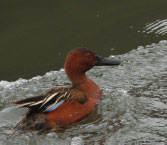 The day does not go without lots of mammal sightings and a few good bird
sightings: a pair of Sandhill Cranes near Ft. Nelson, a heard-only Varied Thrush
at Steamboat, Mew Gulls, Bohemian Waxwings and Golden-crowned Sparrows at Muncho
Lake and a pair of Cinnamon Teal at Toad River. Today’s mammal list includes
Hoary Marmot, Red Squirrel, Least Chipmunk, Mule Deer, Elk, Moose, Caribou (many
times), Wood Bison and Stone Sheep. As we sit around a campfire beside Toad
River, we watch nine Elk graze high above us on a distant mountain slope. In the
marsh ponds below us, we watch ducks feed and are surprised to watch a Sora
swimming between grassy shores – I didn’t know Soras swim. It’s hard to break
away this evening from this beautiful scenery, the warmth of a campfire and the
setting sun, the sweet taste of s’mores prepared over the fire, and the pleasant
conversation of friends.
The day does not go without lots of mammal sightings and a few good bird
sightings: a pair of Sandhill Cranes near Ft. Nelson, a heard-only Varied Thrush
at Steamboat, Mew Gulls, Bohemian Waxwings and Golden-crowned Sparrows at Muncho
Lake and a pair of Cinnamon Teal at Toad River. Today’s mammal list includes
Hoary Marmot, Red Squirrel, Least Chipmunk, Mule Deer, Elk, Moose, Caribou (many
times), Wood Bison and Stone Sheep. As we sit around a campfire beside Toad
River, we watch nine Elk graze high above us on a distant mountain slope. In the
marsh ponds below us, we watch ducks feed and are surprised to watch a Sora
swimming between grassy shores – I didn’t know Soras swim. It’s hard to break
away this evening from this beautiful scenery, the warmth of a campfire and the
setting sun, the sweet taste of s’mores prepared over the fire, and the pleasant
conversation of friends.
(Shari) I wonder what is taking Bert so long to unhook the car. I call him over the radio and ask if he needs any help. “Shari you better come here”, he says, “Our drive shaft is gone.” I wonder, how can a 5-ft. long, 4-in. diameter piece of metal be gone? Sure enough, it is gone. Why anyone did not see it drop is a wonder. It could have fallen out at anytime during the last two days. So our car is dead in the water and will remain hooked up to R-Tent-III for the next two weeks until we reach Anchorage. I tell Bert it is a good excuse to get a new car; I am sick of that disconnect. Remember a few days ago when I wrote that I did not think we had heard the end of the problem disconnect story? We may be at its end soon though. Another rig also had a mishap and tore the awning off of their rig when they turned into the campground. We otherwise had a spectacular day enjoying gobs of wildlife, gorgeous scenery and great company. After our mishaps we carpool to Muncho Lake and ooh and ah over its aqua color even when covered in a thin layer of ice. We enjoy watching the ice drift towards shore sounding like jingle bells at Christmas. Before we return home, we are treated to caribou and mule deer. Jim and Donna have a campfire started overlooking the river near Chris and Curt’s rig. We listen to a bird/mammal count, eat s’mores, sip wine, watch the birds that happen by, watch caribou on the hill. It does not get much better than this and I joke that I am going to stay here until the next rain.
(Shari) Because the scenery is just so fantastic, we take over two hours to make a 70-mi. trip. We skirt Muncho Lake and stop at a high cliff overlooking the ice-covered lake. I try to capture its beauty with digital still pictures, knowing that it never works. This time I also try making a small digital movie panning the scene from left to right hopefully capturing the incredible blue water, glistening ice and sparkling snow-capped mountains. We’ll see. Arriving at Liard River Hot Springs Provincial Park I am relieved to learn campsites are available after the Canadian long weekend. I tell the attendant that I have 10 more rigs following within the next two hours and she will save room for them. Bert leads a walk through the park, while I put ingredients together for our stone soup supper. At 3 PM I put my sweats over my swim suit and Bert and I hike to the upper hot spring for our regenerating bath. My sore knee feels better and better as I soak and I dream that when I get out of the water I will be 20 years younger. When I finally get out, if not younger, at least I am quite relaxed and my skin all nicely pink. Later the homemade soup and cornbread hits the spot as we huddle around the fire enjoying its warmth.
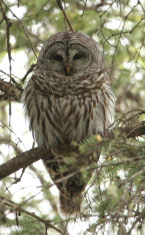 (Bert) Mammal sightings of 10 species again are a highlight of the drive to
Liard River. I add Coyote to our list; others get good views of Stone Sheep.
Bent and Marie and Shari and I arrive quite a bit earlier than the others at the
campsite and the attendant tells us of an owl they have been hearing nearby, but
as yet no one has identified it. I search for 20 min., not finding it in the
area they suspected. While I go back to R-Tent-III to retrieve a book to show
them, the attendant says she heard it again, but farther back. I search that
area and within a few minutes find the Barred Owl perched high in a dense tree
cluster. I take several photos and show the attendant and a gathering of other
workers, all now excited about the owl they will name Barney. This owl is at the
northwestern limit of its range and they tell me this is the first time they
have heard it in the provincial park.
(Bert) Mammal sightings of 10 species again are a highlight of the drive to
Liard River. I add Coyote to our list; others get good views of Stone Sheep.
Bent and Marie and Shari and I arrive quite a bit earlier than the others at the
campsite and the attendant tells us of an owl they have been hearing nearby, but
as yet no one has identified it. I search for 20 min., not finding it in the
area they suspected. While I go back to R-Tent-III to retrieve a book to show
them, the attendant says she heard it again, but farther back. I search that
area and within a few minutes find the Barred Owl perched high in a dense tree
cluster. I take several photos and show the attendant and a gathering of other
workers, all now excited about the owl they will name Barney. This owl is at the
northwestern limit of its range and they tell me this is the first time they
have heard it in the provincial park.
By mid day I’ve taken almost everyone in our group to see the sleeping owl. We then walk along the boardwalk, slowly so as to observe the wildlife in the swallow warm-water marsh, finding Semipalmated Plovers, Greater Yellowlegs, Solitary Sandpiper and Pectoral Sandpiper. In the wooded areas we find a couple of singing Hammond’s Flycatchers and I photograph one of them. Some of the group continues birding and the rest of us get our swimming suits and return to the hot springs for a relaxing swim. The air is chilly as we make the return hike. Gathered around a crackling campfire, I hand out and discuss a sheet describing large mammals we have and will encounter. At the bird and mammal count off around a campfire, Bill announces he had a Boreal Chickadee visit his campsite and John tells us about the Golden Eagle he watched at the cliffs we passed on our drive here today. With the sun now behind the trees and a cold wind picking up, we welcome eating Shari’s stone soup, the warmth heating our insides even as our outsides are chilled in spite of layers of clothes. Chocolate s’mores around the campfire top off another good day.
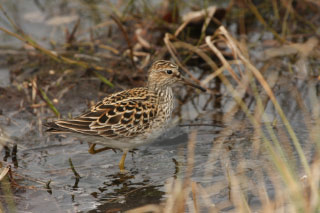 (Bert) Leaving Liard River Hot Springs we pass Bison five times in groups of
4-10. These are the endangered subspecies Wood Bison – as opposed to the more
common Plains Bison. The huge animals graze along the 100-200-foot-wide grassy
shoulders and we see groups from mile 7 to 42 today. Other mammals are again in
good numbers, including Ermine at Liard River, the Cross Fox morph of Red Fox,
Black Bears twice, White-tailed Deer, Mule Deer, Moose and Snowshoe Hare.
Although we stop several times to look for birds the perpetual drizzle has put a
dampener on finding much of anything with wings. A Western Wood-Pewee is a nice
find at Coal River and a silent Empidonax flycatcher gives us pause at Contact
Creek. Studying its field marks I suspect Hammond’s and John concurs after
studying his photographs. Although I do not see many birds during the rainy day,
at the count off this evening the cumulative list is more impressive with
additions of Ruffed Grouse at Iron Creek, Common Loon at Lucky Lake, American
Tree-toed Woodpecker at the burn area and Tennessee and Townsend’s warblers at
Liard River. Marie reports another pair of Cinnamon Teal, these at a pond near
the BC-YT border, about 11 mi. before Watson Lake. Range maps in leading field
guides do not show this species much beyond the southern parts of British
Columbia and we are hundreds of miles farther north.
(Bert) Leaving Liard River Hot Springs we pass Bison five times in groups of
4-10. These are the endangered subspecies Wood Bison – as opposed to the more
common Plains Bison. The huge animals graze along the 100-200-foot-wide grassy
shoulders and we see groups from mile 7 to 42 today. Other mammals are again in
good numbers, including Ermine at Liard River, the Cross Fox morph of Red Fox,
Black Bears twice, White-tailed Deer, Mule Deer, Moose and Snowshoe Hare.
Although we stop several times to look for birds the perpetual drizzle has put a
dampener on finding much of anything with wings. A Western Wood-Pewee is a nice
find at Coal River and a silent Empidonax flycatcher gives us pause at Contact
Creek. Studying its field marks I suspect Hammond’s and John concurs after
studying his photographs. Although I do not see many birds during the rainy day,
at the count off this evening the cumulative list is more impressive with
additions of Ruffed Grouse at Iron Creek, Common Loon at Lucky Lake, American
Tree-toed Woodpecker at the burn area and Tennessee and Townsend’s warblers at
Liard River. Marie reports another pair of Cinnamon Teal, these at a pond near
the BC-YT border, about 11 mi. before Watson Lake. Range maps in leading field
guides do not show this species much beyond the southern parts of British
Columbia and we are hundreds of miles farther north.
After parking our RV’s at a Watson Lake campground, we walk part way around Wye Lake, clear of ice since this past weekend but so overflowing its shoreline that we cannot hike completely around the small lake. We add White-winged Scoter and Long-tailed Duck, but do not see any of the loons that are usually present. A surprise is a Pectoral Sandpiper I almost step on and it continues to feed in short marsh grass while we watch it at incredibly close range.
(Shari) After arriving at Watson Lake, I accompany Steve and Nancy for my first geocaching experience. It is way too easy and Steve reaches the cache before I get a chance even to look for it. Previously I had put the coordinates that were on the web for this site into “May”, my GPS. She leads me to within 200 ft. of the cache but I see I would need another more accurate GPS to follow if I do more of this. “May” can get me close but I think I would look forever to actually find the cache. This time the find is so easy that I never have a chance to try since Steve has it in his hands before I even look up. The cache is a large empty plastic peanut container with all sorts of small goodies inside. Steve and Nancy put in a small car and take out a serialized item that will be logged and traced to the spot where they drop it off next. I walk to the visitor’s center and museum before heading back to R-Tent-III in the drizzle. It has been a drizzly day for driving today but should clear by tonight. Nonetheless, we conduct our bird trip count, travel meeting and social under the covered porch of the campground office. I tell Mel he should have a birthday every week since Joann made such wonderful snacks to share with us.
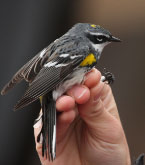 Day 6 - May 21 - Whitehorse, YT
Day 6 - May 21 - Whitehorse, YT (Shari) Six AM is too early to get up in the morning and I am crabby. I tell Bert I do not want to go see the bird banding but, unfortunately, I have to get up because the place is on the way we will take our RV’s. Seven miles down the highway, we stop at the side of the road to stage the group. Bert and Jim drive ahead in his Jeep to determine if the banding place is open. It is and so Jim ferries the whole group the 2 mi. to the banding location. By this time I am awake enough and decide to go along, joining the last group out. My new rain boots get their workout as I follow a young girl through the soggy woods to a mist net. Five little birds are caught and I feel sorry for them as they struggle to get out. The young girl manning the station gently takes each bird by the legs and puts them in individual bags before she returns to her posting. She then takes the birds out, bands one of their legs, blows on their breast to determine fat content and weighs them upside down on a small scale before releasing them back into the wild. It is truly amazing and she tells us some days she gets 80 birds and some days only 3. Today looks like a record day to me since I watch her do 12 birds in less than 45 min. We’ve got miles yet to travel so we must tear the group away from this fascinating place. I don’t know what someone did with my sunshine but today it alternates between cloudy, drizzly and a few rays of sun. I think when the forecast is 30% rain it means it will rain 30% of the day. The weather does not color the scene however and we are able to stop at our favorite places to add birds to the trip list. Since we arrive later than hoped we cancel the scheduled bird talk to allow time to prepare for dinner out. The restaurant is great again and every one tells me how good their entrée was. My lamb chops too are excellent, although I still can’t get over the sticker shock when the bill arrives. Let’s go back to the days when the Canadian dollar was 80% of the US dollar.
(Bert) The Albert Creek Bird Banding Station is operational this morning, unlike two years ago when the rain prevented us from visiting. Jim shuttles four people at a time between our rigs parked at the side of the highway and the banding location nestled in a watery marsh reached by a winding gravel road. Just as I arrive, the young lady is banding a Yellow-rumped Warbler, the most numerous species in the marsh. She is also weighing each bird and recording age and body fat. We accompany her to one of the mist nets, empty this time, and are amazed at the dozens of warblers buzzing all around us. I see Wilson’s Warblers and Common Yellowthroats, a Northern Waterthrush is caught and banded and after I leave a Blackpoll Warbler is captured. Marie hears a Ruffed Grouse drumming and after several unsuccessful attempts I finally hear the beating wings as well.
Our next stop is at Rancheria Falls where I remember finding American Dipper another year. Snow piles still edge the parking lot – and all of the mountains are snow-capped today. The hike through the woods leads to an elevated boardwalk and then to two short deluged waterfalls. It doesn’t take long before Curtis finds a dipper and then we see a second, this one intent on collecting twigs and grass that it flies across the stream to a nesting site in the rock embankment near the falls. We watch it fly back and forth dozens of times. We stop again at Teslin Lake, a place I usually find only a few good birds, but this time I see none at all. I guess the solidly frozen lake offers little food for migrants. Mammals are sparser today, but I have already seen Caribou twice and a Moose this morning. Thirty miles farther, as I am crossing Teslin River I look down and spot a Pacific Loon floating far below the big bridge. Our last stop is at Jake’s Corner where I am keen on finding Mountain Chickadee, a very local bird to this part of the Yukon Territory. It is not at the roadside bushes where I found it once before. Soon we are distracted by a Say’s Phoebe and then continue walking around the buildings and junk piled on the hillside. I hear a call that might be the chickadee and return in the direction of the parked RV’s where I see Marie intently focusing her binoculars on a spot in front of their RV. I follow her view line and see the singing Mountain Chickadee perched on the same bush I looked at 20 min. earlier, i.e., the same bush it was in two years ago.
(Bert) “There’s a Eurasian Wigeon”, announces Mel while peering through his spotting scope. A unison call “Where?” comes from the rest of us. Four more scopes try to find the spot across the water pools and mudflats at M’Clintock Bay and soon all of us are watching the adult male wigeon feeding amongst Green-winged Teal, Long-billed Dowitchers and American Wigeons. For Steve and Nancy it is an especially propitious bird since it is their 500th life bird. We were sidetracked from studying swans and now return to the discussion of Trumpeter versus Tundra, eventually deciding the dozen or so are Trumpeters. Thousands of swans migrate through this bay of the Yukon River. We find one straggler Snow Goose held back from the migration, all the others long past this point.
We drive to downtown Whitehorse and check for birds on the Yukon River, now a narrow creek rushing through gravel flats covered with ice and snow. Surprisingly, we find almost no birds except for both a Common and few Red-breasted mergansers. We are about to leave the parking lot when John and I both watch a high-flying gull. We have been seeing only Mew Gulls and he asks me if it is an immature Mew. I’m not sure and say I’m puzzled by the terminal black band on the tail. It looks like a Ring-billed Gull between juvenile and adult plumage but Ring-billeds are rare in the Yukon. After studying the books though, we reach the conclusion that it is the only likely possibility.
In the afternoon we visit McInytre Creek wetlands where 6-8 Bald Eagles soar above us. We continue on the gravel road to Fish Lake, still solidly frozen over and devoid of birds. John spots a pair of Arctic Terns hawking insects above the iced lake, his second life bird of the trip. On the return trip I’m keen on finding a Dusky Flycatcher and I had read that they can be found along this road. When we reach an area mostly devoid of spruce, replaced by lower shrubbier habitat, I suggest we stop. Almost as soon as we get out of the cars, I hear a distant call I do not recognize and think it might be our target bird. John plays his tape of Dusky Flycatcher and within seconds the bird flies to a low barren tree near where we stand. We get a good look at the Dusky and notice a contrast between it and the Hammond’s we’ve seen in the past 2-3 days, this one being darker olive, a rounder bolder eye ring and a tail that looks quite long. The Dusky Flycatcher is a life bird for several in the group, including Chris who has done this trip with us before.
(Shari) My eyes do not open until I hear Bert leave for the birding trip at 8 AM. I have a wonderfully relaxing morning even if it is full of chores like washing clothes, caravan accounting and updating road logs. Using my WI-FI phone I call Remco and tell them of our driveshaft predicament. Since I hear no answer, I ask if the man is still on the line. He responds that he is but that he is in shock since all of his 17 years at Remco he has never heard of a driveshaft disappearing. He gives me a phone number in Anchorage to call. When I call that number I am told that no parts can be ordered until they look at the car. The man there seems to think I need more parts than a Remco unit. He mentioned the word “drive train”. I do not want to know what that entails, but it sounds big. After lunch Curt graciously takes me to town. We visit the Yukon brewery and are delighted with a free tour and free tasting. I end up buying more than I had intended since the beer is soooo good. Then we visit the grocery store for some fruit and bread and as we are driving home, we stop at a Honda dealer. None of the doors of the cars are open but the CR-V’s look good. The sticker price is $10,000 more than what I saw as the suggested retail quoted on the web. At 5 PM, I go outside with my glass of wine and snacks and look for a party. Curt says to come to his rig and soon we have a group of people huddled under his awning to get out of the drizzle. Steve talks about geocaching some more and tells us of one he and Nancy found in a beautiful canyon. They found a total of five today. Later I look on the web for cache sites on the road between Whitehorse and Tok, but have no luck. I guess I will have to wait until Palmer or Anchorage to do any more looking.
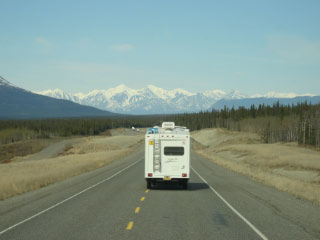 Day 8 - May 23 - Destruction Bay, YT
Day 8 - May 23 - Destruction Bay, YT (Shari) As Nancy from a previous caravan would say, today is “Drop dead gorgeous scenery at every turn”. Also, we could not have picked nicer weather to travel this segment of the road. The sun shines on the mountains and the snow-covered peaks just glisten. At one particularly beautiful point Steve jokingly announces, “Yup, I’d rather be attending a staff meeting”. We stop many times along the route to take pictures and soak in the beauty. Bert manages to get some birds and I manage to recharge my soul’s battery with magnificent surroundings. At the bakery across the street from Kluane National Park I am disappointed to learn that they are sold out of cinnamon rolls. I specifically called on May 14 to ask them to put some aside for us. Apparently Liz forgot. Darn! At least Ginny and Marlene got some. At Sheep Mountain we see more sheep than I have ever seen in my previous four times of traveling this route. Bert counts 80 and the attendant mentions 86 seen on the hillside this morning. At Destruction Bay, so named in 1942 for wind destruction of the Alaska Highway construction camp, we enjoy a steak barbeque in the warm outdoors, complete with fresh salad and smoked baked potatoes. After dinner, Loren and his friend Tim entertain us with songs and stories of the Yukon.
(Bert) Earlier along the Alaska Highway we slowed down for a small herd of horses on both sides of the road. Now again today at mile 35, 37 and 55 we encounter “wild” horses grazing. I do not remember ever seeing free ranging horses on previous trips and I wonder if the redesign of the highway with broad grassy shoulders is responsible for these appearances. The drive toward Haines Junction is as spectacular as ever. Photos through our windshield of Steve and Nancy’s RV on the highway in front of us show the miniscule vehicle compared to the gigantic snow-covered mountains of the St. Elias Range. We stop at the visitor’s center for Kluane National Park and a group of us hike toward a spot behind a gas station where I remember seeing Mountain Bluebirds two years ago. Not seeing any when we arrive, I ask the owner about them and he says for the first time in nine years the bluebirds did not come and he repeats a line we’ve heard many times now, “Spring is 2-3 weeks late this year”. The late spring is certainly evidenced in the near absence of tree leaves on the aspen. On the hike back to the RV’s we see a finch-sized bird fly into a tall spruce, but it takes 15 of us viewing the tree from different angles for 4 min. before Betty spots the White-winged Crossbill hiding in the needles. It is a yellow-orange female and lifer for several in the group.
Continuing our drive alongside the mountain range, Bent announces a Gray Wolf beside the road, something we passed by and missed. Marie’s sharp eyes spot more birds too that we miss. It’s not hard to see the Dall’s Sheep though when we stop at Sheep Mountain. Scattered in small groups, many with newborn lambs, I count 80 sheep across the broad mountain slope which rises to a peak 5000 ft. above us on the shores of Kluane Lake. Near the top I see a hawk flying, first harassed by a small hawk or falcon and then chasing another same-sized hawk. We suspect several species that could be expected here, eventually reducing the gray coloring and white rumps to Northern Harriers, two males chasing each other at an altitude we rarely see them.
At our 4:30 outside gathering beside Kluane Lake I describe the scenery around us: the uprising St. Elias Mountains to the south, the Shakwak Valley as the southern extension of the Denali fault stretching into Alaska, and opposite Kluane Lake to the north the Ruby range and Kluane and Yukon plateaus – all composing the collision of the tectonic plates, a dramatic illustration of the results of continental drift and the type of events that ultimately formed Alaska as an adjunct of the North American continent. The lake, largest in the Yukon, is still covered with ice, although recent rains have accelerated its melting. Loren, the campground owner, says that only yesterday did 20-in. of the active layer above the 150-ft. deep permafrost thaw enough for him to turn on the water leading to faucets.
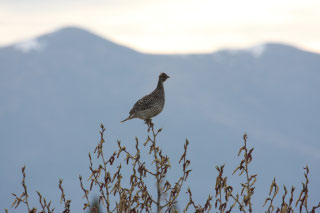 Day 9 - May 24 - Beaver Creek, YT
Day 9 - May 24 - Beaver Creek, YT (Bert) I’ve seen Sharp-tailed Grouse before, but not without their feet on the ground. So I’m surprised when I see one perched atop a leafless 15-ft. aspen beside the Alaska Highway. This one waits while I take photos out of a side window of R-Tent-III and is still there as half our caravan passes by the site. Although those arriving later miss the grouse, they pick up a Northern Hawk Owl that Bill spots and watch as a harrier harasses it. We stop at Burwash Landing, a small community on the shores of Kluane Lake. In the bay the lake ice has turned to slush and much of this part is glassy clear water with broad gravel flats. Six Trumpeter Swans feed in the shallows, the first of 18 we see in route today, widely separated at six small lakes. A few gulls, terns and sandpipers are on Kluane Lake, the most unusual being a single Dunlin, listed as rare on the Checklist of Yukon Birds. We encounter long stretches of frost-heaved pavement interspersed with gravel road in the process of being repaved. At least it seems like long stretches since I am driving at 10-15 mph most of the time, either to avoid the bounce of the frost heaves or to avoid stirring up too much dust as R-Tent-III is unusually susceptible to getting a clogged air filter, a very expensive part and labor cost. The slow speed gives us lots of opportunity to bird along the way and with frequent stops we find 14 species of ducks. The best stop is Pickhandle Lake where I’ve always found a pair of Rusty Blackbirds. Bill is the first to spot them just as they are about to mate. Later the male sings from atop a spruce and for the first time I, with John and Chris, find a second male a couple thousand yards along the highway toward a second lake. I see yet a third pair when we stop at Snag Junction Campground, a good sign for this increasingly difficult-to-find species.
The day is not without mammal sightings and we record seven species at count-off, including Black Bear, Coyote and Porcupine. At Beaver Creek I give a presentation on grouse and particularly Ruffed Grouse. Shari likes my imitation of a grouse on its drumming log. The day has been extremely pleasant and just before we head to the Beaver Creek Rendezvous show I look at the outside thermometer and see it is 81.5º. After the show – excellent, by the way - it is still 74º at 9:45 PM. There is a special song the cast sings at the end of the show and looking back at my journal for this day two years ago I see that I wrote down the lyrics. They so much capture the feeling of the past few days that I will include them here again.
You never can forget the wilderness,
No matter what you do.
Once you’ve been up here in the wilderness,
It becomes a part of you.
Beautiful mountains and rivers,
Far as your eye can see.
The way it all used to be,
Where eagles can fly to the end of the sky.
So when you're back in the city and caught up in the strife, J
Just remember the time you were here and how special it was in your life.
(Shari) “Bumpity bump, bumpity bump, bumpity bump on the Alaska Highway”, goes the chorus line of the song. The road has improved over the years but still has many frost heaves and pot holes. The day is pretty and the scenery again gorgeous. We break up the drive with stops at Bert’s favorite birding locations. At one stop, a group of travelers are using the same CB channel that we use and we hear them talking amongst themselves. They pass us by and do not say complementary things about the caravan. The language they use belongs in a gutter and Bert especially gets irritated when they call the guy with the camera lens as big as a telescope “an old gizzer”. Of course he says they were not talking about him since he is only 39 years old. Yeah, and if you believe that I have some property to sell. We arrive at Beaver Creek in plenty of time to relax and listen to a bird talk on grouse before we get ready for the dinner show. As soon as Officer Ernest Friendly learns that Ann’s husband Curtis is home sick and not with her tonight, he starts the flirting that lasts all night long. Ann also is called upon to show us the can can dance that she apparently used to do in her younger days (at least according to the show’s actress). Food is delicious and the show is as fantastic as I remember it to be. We all have a wonderful time but hurry home to get some shut eye. Tomorrow is a long day.